When choosing cameras and lenses, nonfiction filmmakers are not only guided by the look, feel, and cinematic language they want to employ, but also by what their production demands and resources allow. Which is why in answering the question of why they picked the gear they used to shoot their Sundance nonfiction feature premieres, this year’s crop of cinematographers and directors also tell us how they shot their movies — the challenges and choices, as well as their cinematic styles.
Check out our survey of this year’s narrative features right here.
The following films from the U.S. Documentary Competition, World Documentary Competition, and Premieres appear in alphabetical order by title.
Section: U.S. Documentary Competition
Dir: Jamila Wignot, DoP: Naiti Gámez
Format: 4k
Camera: Canon c300 mkII & Canon c300 mkIII
Lens: Canon CN-E Cine primes; CN-E30-105mm zoom & L-series lenses.
Gámez: We wanted nimble and affordable documentary cameras and lenses that would allow us to film dancers, rehearsals and subjects in any setting. For the dance rehearsals, we really focused on capturing the nuances of the movements and the flow of the dancers’ interactions. For the sit-down interviews, we knew we wanted the sets and subjects to really shine. We wanted their stories to feel elevated and dramatized, yet contextualized. So, we decided on a look that was our imagined, hyper-stylized version of what “backstage” behind an Ailey production would look like: with props, cloths, grip equipment, and pieces of set designs framing them.
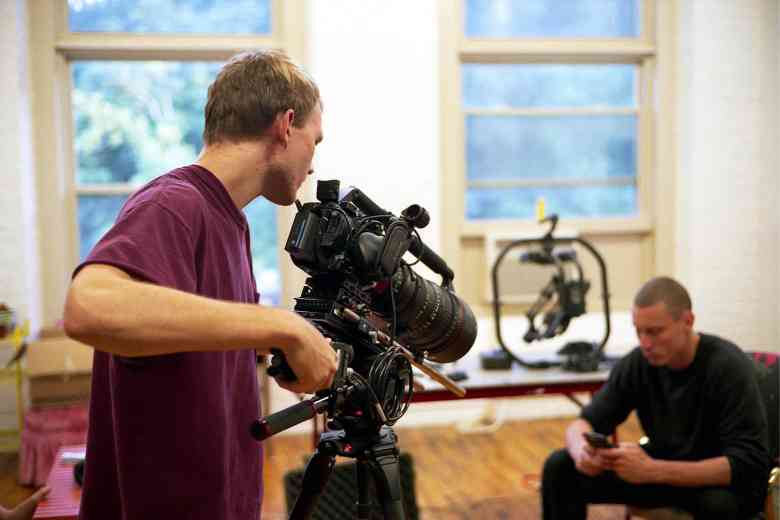
Corey Hughes Shooting “All Light, Everywhere”
courtesy of filmmaker
Section: U.S. Documentary Competition
Dir: Theo Anthony, DoP: Corey Hughes
Format: 4k, 1080p, 720p
Camera: Sony FS7 & FS5, D-Eye Retinal Cam, FLIR ONE, DJI Mavic & Inspire 2, Olfi one.five, Axon Body 2
Lens: Canon 30-300mm, Fujinon Cabrio 20-120mm, Zeiss CP.2 (15mm & 35mm), Canon 24-70mm, Leica Summicron 50mm
Hughes: Due to the kaleidoscopic nature of the project, weaving multiple narratives and histories together, the cinematography of the film developed with each section we filmed. The main threads of the film were shot on the Sony FS7 and FS5. We switched between shooting single camera on a Movi and filming multi-cam on tripods with cine zooms. The cine zooms allowed for flexibility in shooting in live environments while also creating some really beautiful and surreal images. The slow mechanical zooms replicate the movement of a surveillance camera, searching and tracking objects in a frame. What I love about the Movi is it produces these extremely digital feeling images. You can feel the operator behind the camera. It is trying so hard to make smooth images but it doesn’t always work. I love those flaws.
Many of the environments we were filming in were unknown with limited access so we had to be able to adapt to changing scenarios. Theo and I developed parameters to work within so that we had a guide for how to react to each new situation. For example, when filming the workers inside the Axon factory we felt it was important to highlight the physicality of the human labor that is inherent in producing tech devices, so one of the parameters became that the camera should always focus on the interaction between hands and objects when filming the workers in the factory.
The film pulls images from many different sources: body camera, software screen capture, aerial surveillance systems, archival materials from the early 20th century, etc. When working with these types of operational images, images created to serve a specific function in a process (ex. surveillance, facial recognition), we wanted them to appear as raw as possible. Respecting the material for what it is rather than trying to morph it into a more traditional cinema image. Grainy 720p Go-Pro footage or software screen capture can be just as powerful as well lit 4k raw footage if used in the right way. We were equally interested in creating compelling images as well as revealing the flaws and biases inherent in the way each camera sees the world.
Section: U.S. Documentary Competition
Dir/DoP: Maisie Crow
Format: 4K
Camera: C300 mkII, 5D mkIV, Panasonic Eva 1
Lens: Canon Zoom Lens CN-E 18-80mm, Canon Zoom Lens 24-70mm f/2.8, Canon Zoom Lens EF 70-300mm f/4-5.6L IS
Crow: The film was shot with a small crew to allow for intimate, unobtrusive access to the students and families we were filming. It was important for us to use cameras that could be operated by a single person so as not to interfere or distract from what was happening in front of the camera. I operated the main camera for the majority of production and ergonomically the C300MKII worked well with my small stature. It was a comfortable camera for me to work with during long shoot days.

“Captains of Zaatari” cinematographer Mahmoud Bashir
courtesy of filmmaker
Section: World Cinema Documentary Competition
Dir: Aly Elaraby, DoP: Mahmoud Bashir
Format: 2k s log 3 & raw
Camera: Sony a7s iii & Red dragon
Lens: Master prime
Bashir: The mix between the dslr camera and pl cinema lenses was my answer for this project. With a small camera I can hold it day and flow with the moment easily and catch moments when I didn’t know what would happen next. In addition, the Sony a7s supplied the option to shoot at night with high iso and high quality lenses, the exact balance and mood I needed.

Isabel Bethencourt shooting “Cusp”
Isabel Bethencourt/Parker Hill
Section: U.S. Documentary Competition
Dir/DoP: Isabel Bethencourt and Parker Hill
Format: 2K Canon Log
Camera: Canon C300 Mk II
Lens: Zeiss Standard Speeds
Bethencourt/Hill: Since we were a two-person team for all of production, the C300 was a no brainer for its small footprint, built-in doc versatility, and low light performance. We could fit the whole thing in a backpack, which kept us super nimble for running around with teenagers at all hours. We loved the standard speeds for their texture and imperfections, and they’re also really small — we could get close to our characters without them feeling like they had a huge lens in their face. The limitation of the primes turned out to be one of our biggest advantages, since it encouraged us to physically move around the rooms we were in, constantly finding new angles and frames. We wanted the film to feel as vibrant and energetic as the girls are, so we were constantly thinking about color — strategically exposing the c300 to preserve color in the highlights, and using colored filters to enhance the golden Texas sun whenever possible.
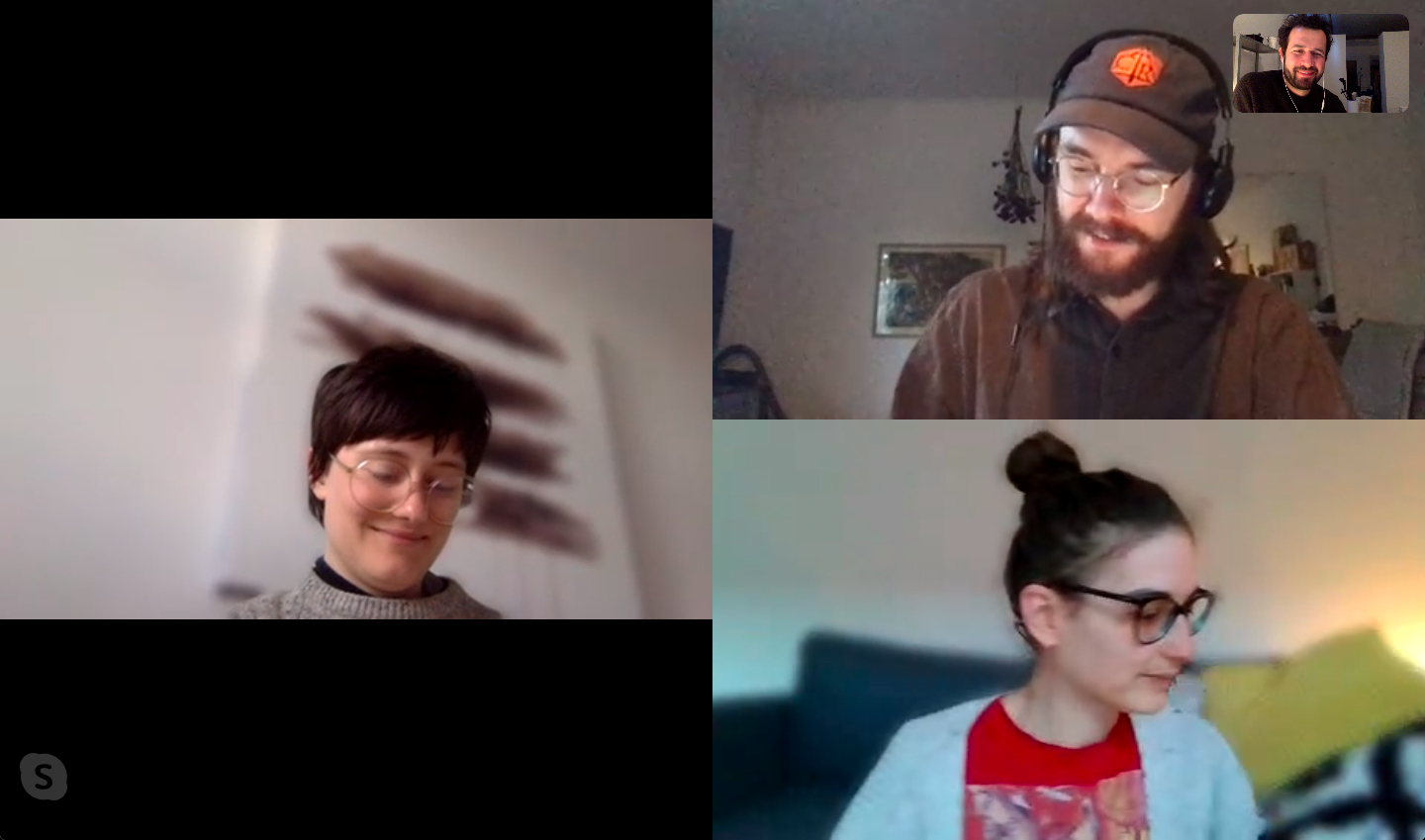
Behind the scenes of “Flee”
Section: World Cinema Documentary Competition
Dir: Jonas Poher Rasmussen Art Dir: Jess Nicholls
Camera: We didn’t shoot, we drew.
Lens: As this is animation we didn’t use real lenses, but we aimed for a style matching lenses in a 35-70mm range
Rasmussen: As we were drawing our scenes by hand, we didn’t have to confront the camera question too much. There is a certain amount that can be faked, or distorted, in the perspective of a shot. At the same time, “FLEE” is an animated documentary and we really wanted to keep an authentic feel to it. We wanted fairly flat but realistic perspective, where we could show a good amount of landscape whilst keeping a lot of strong parallel lines. Our main types of shots were wide, establishing shots, that benefitted from the vastness of the space; medium close ups for dialogue and character interaction, where negative space and creating distance between characters was important; finally, extreme close ups were used for moments of high tension and stress, to isolate important objects or people from an out of focus background.

“Homeroom” cinematographer Sean Harvey
courtesy of filmmaker
Section: U.S. Documentary Competition
Dir: Peter Nicks, DoP: Sean Havey
Format: 4K
Camera: Sony F5 and A7S
Lens: Canon 24-70mm f2.8 and 70-200mm f2.8; Sigma 50mm T1.5
Nicks: Our films are all about proximity to character, bringing the audience into the emotional world of the people we are following. These are stories that sometimes span years that need to be shot on gear that we own. For these reasons we are typically unable to use expensive rigs and lens sets. We shot “Homeroom” on a combination of the Sony F5 and A7S with canon dslr zooms (24-70mm f2.8 and 70-200 f2. with camera support provided by a Movi gimbal and an EasyRig. This lens set is a great lightweight cost effective option for shooting vérité documentary. It offers versatility with foal range and a shallow depth of field, but not so much depth of field that focus is too much of a challenge. When appropriate we would shift to primes (Sigma 50mm T1.5) if we had more control over the scene and wanted a look/feel with more intimacy and character.
with camera support provided by a Movi gimbal and an EasyRig. This lens set is a great lightweight cost effective option for shooting vérité documentary. It offers versatility with foal range and a shallow depth of field, but not so much depth of field that focus is too much of a challenge. When appropriate we would shift to primes (Sigma 50mm T1.5) if we had more control over the scene and wanted a look/feel with more intimacy and character.
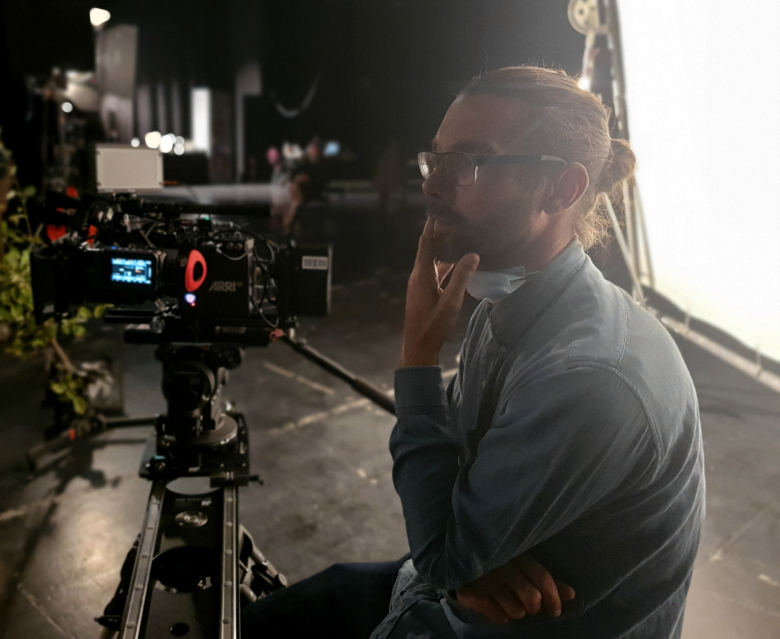
“Misha and the Wolves” cinematographer Will Pugh
courtesy of filmmaker
Section: World Cinema Documentary Competition
Dir: Sam Hobkinson, DoP: Will Pugh
Format: 2K, Prores 4444
Camera: ARRI Alexa Mini
Lens: Angenieux Optimo T2.6 15-40mm, Angenieux Optimo T2.8 45-120mm
Pugh: This was not an observational documentary but a carefully constructed, retrospective story with lighting and design elements – ultimately envisaged for a big screen. We wanted a high level of image quality but equally a light footprint, to work in real locations with minimal crew. To that end, I shot with Alexa Mini at 2K, in Prores 4444, using Angenieux Optimo compact zooms 15-40mm and 45-120mm. Occasionally we used a TLS Morpheus 80-200mm and Tokina 100mm macro.
Despite different countries, locations and timeframes, we wanted our interviews to have stylistic cohesion, so locations were all carefully scouted, framed and lit. Interviews were conducted centre-frame and into-the-lens (using EyeDirect) which works well for first person testimony. This is a film about a dark period of history and about layers of deception. The visual style of the film is still and composed. We eschewed handheld. Movement where it exists is creeping or occasionally gliding. We wanted the lighting to feel natural but to have mood and contrast, and for the imagery to play with textures, frames and surfaces.
It goes without saying that 2020 was a tricky year for production, and of course our budget was limited, so director Sam Hobkinson took advantage of a family trip to Germany to film some snowy mountain scenes featuring his daughter – amazingly pulling it all off on his own using a Lumix GX8 with a 20mm lens mounted on a small gimbal. Outside of the U.S material I shot for Sam in 2015, we were unable to fly to the States in 2020 for a week’s shoot, which I ended up prepping and handing over to Stephen McCarthy, a great DOP based in Boston. Stephen did a seamless job with Sam directing remotely (thankfully there had been a scout pre-Covid!). This film was a long passion project for Sam and it was great to play a part in bringing this incredible story to life.
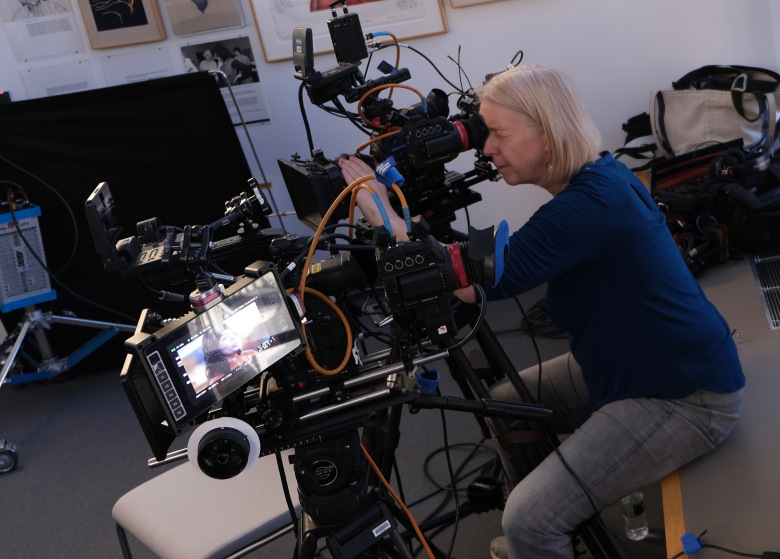
“My Name Is Pauli Murray” cinematographer Claudia Raschke
Casey Joseph
Section: Premieres
Dir: Julie Cohen, Betsy West, DoP: Claudia Raschke
Format: 4K
Camera: Canon C300 Mk2
Lens: Canon Cinema Primes, 17-120mm Canon Cine Zoom, 18-80mm Canon Compact cine zoom
Raschke: “For My Name Is Pauli Murray” the Canon C300ii and the Canon cinema primes were a fantastic combination to express beautiful, glowing skin tones with a high contrast background, including deep shadow details and exquisite highlights, for the interview set-ups in our feature documentary. My natural soft lighting approach was inspired by the Dutch painter Jan Vermeer. Light source motivations were set up to match the particular location either with natural existing or imagined window sources while treating the background by setting specular highlights.
Choosing a shallow DOF and cinema primes allowed me to transform my lighting design into the painterly look I desired. The Canon sensor allowed me to maintain my cinematic style throughout the film and especially during challenging documentary situation. Without the sensor’s latitude and easy to modify camera settings I wouldn’t have been able to instantaneously capture and react to unpredictable cinéma vérité moments.

Behind the scenes of “Philly D.A.”
Ted Passon
Section: Premieres
Dir: Ted Passon, Yoni Brook, DoP: Yoni Brook
Format: 2K 444
Camera: Canon C300MK2, RED Gemini
Lens: Canon 24-70, 150-600
Brook: I wanted to put our audience in the seats of the most powerful people in the justice system: the prosecutors. They operate behind-closed-doors and our cinematography was an opportunity to pierce that bubble. As an observational docu-series, we shot nearly a thousand hours of intense meetings. Our scenes unfolded in ugly conference rooms with no opportunity to change the lighting.
To create a feeling of intimacy, I rested the camera on my hip pouch during long meetings to be at the same eye level as the people gathered around the conference tables. It was essential for myself and co-creators Ted Passon and Nicole Salazar, who often operated sound, to be in creative sync while being completely silent. That meant often just using eye movement and tracking the boom mic. For our cityscape scenes that showcase Philadelphia, I wanted to stay away from drones, and instead used vintage telephoto zooms to achieve the deep-focus of classic observational documentaries, like “Streetwise” and “The War Room.”
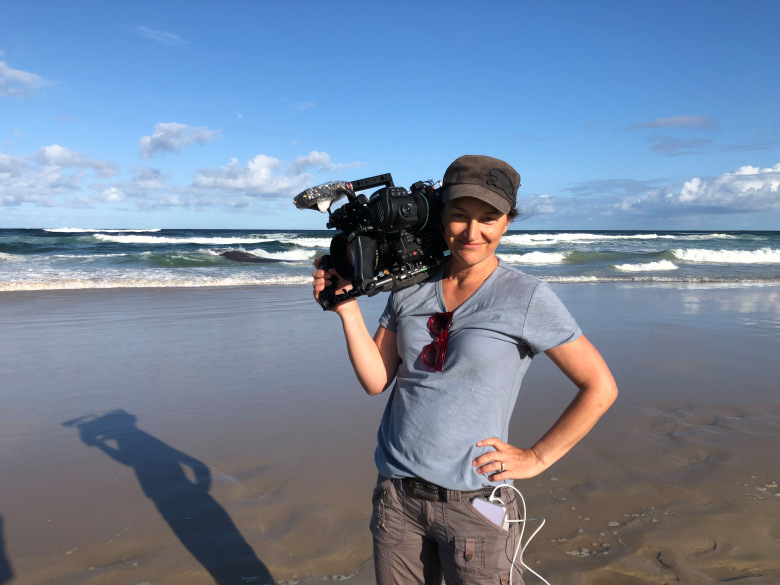
Behind the scenes of “Playing with Sharks”
Section: World Cinema Documentary Competition
Dir: Sally Aitken, DoP: Ron Taylor, Judd Overton, Nathan Barlow, Michael Latham, Jono Heighes
Format: 16mm, 35mm, 4k
Camera: Arri Alexa Mini, additional cameras: Sony F55 a7iii DJI Mavic 2 Drone (Plus archival cameras: 16mm and 35mm Bolex and Arri)
Lens: XEEN Cine Prime Lenses
Aitken: “Playing with Sharks” is Valerie Taylor’s incredible story — pioneering shark expert, fearless underwater icon, and maverick conservationist. With both archival and contemporary footage in the film I was keen to honor Ron Taylor’s incredible film library gathered over a half century as well as reflect the energetic vibrancy and sage wisdom of 85-year-old Valerie today. So this movie is a contemporary story and a journey through time… something of an artistic challenge!
Ron’s remarkable underwater scenes from the 1950s, 60s, and 70s were brought back to life after production company Wildbear Entertainment contracted the Blackmagic cintel scanner. The colors in the film stock popped brilliantly, and the quality of the image had not diminished. What Ron captured, reefs swimming with plentiful sharks, have however become almost impossible to film today — the confronting realities of a depleted ocean.
Our contemporary cinematography; shot by Judd Overton, Nathan Barlow and Michael Latham, of Valerie in the present day still diving without Ron. The impressionistic imagery I wanted to film, such as the ‘tinny’ (the Taylor’s runabout boat), and all our interviews required a clean modern look with high-end cameras and prime lenses for beauty. We wanted to intercut present-day with the past, and so an Alexa Mini afforded us some maneuverability while on location and also a high quality look for observational sequences.
A DJI mavick 2 drone swept along the Australian coastline, and also in Fiji, helping us realize grand scale in our climactic scene of Valerie free diving with Bull sharks with a small dive boat set against the epic blue of the Pacific Ocean. These kinds of aerial images were impossible to achieve in Ron’s time (without enormous budget) so they further enhanced the experience of the present against the past. I also wanted to fully immerse viewers in the magnificent underwater experience of the Fiji dive. Again, the Alexa Mini was used, with principal underwater filming from Valerie’s nephew, Jono Heighes, who apprenticed under Ron Taylor. The 60-odd Bull sharks swirling around an octogenarian in a pink wetsuit also play their part in making the scene magnificent!
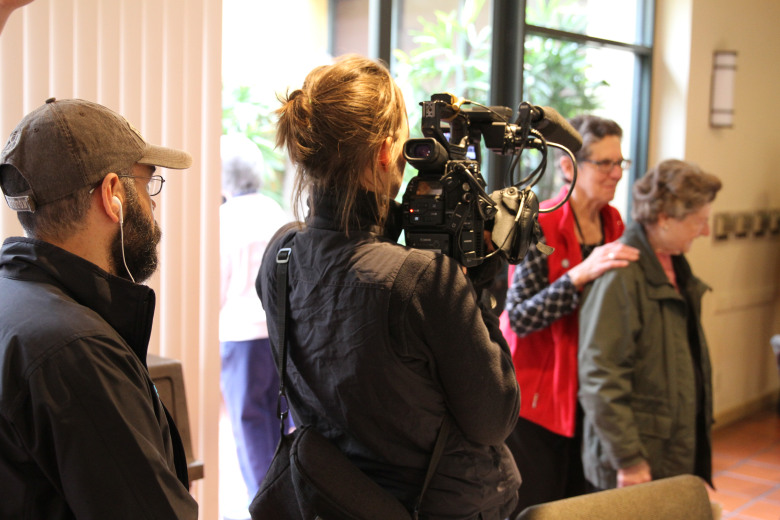
Shooting “Rebel Hearts”
courtesy of filmmaker
Section: U.S. Documentary Competition
Dir/DoP: Pedro Kos
Format: 4k, HD, DV
Camera: Canon C300 mark 2
Lens: Canon L Series, 35mm prime and 70-200
Kos: “Rebel Hearts” is told with a combination of archival footage of various formats, animation and motion graphics, and original contemporary footage. We wanted the contemporary footage to help ground and frame the story in the present. We love the look of the Canon C300 Mark 2, and the Canon lenses. They allowed us to be nimble, intimate and at the same time have a rich and cinematic look that feels like the here and now, and yet blends well with all the other elements.
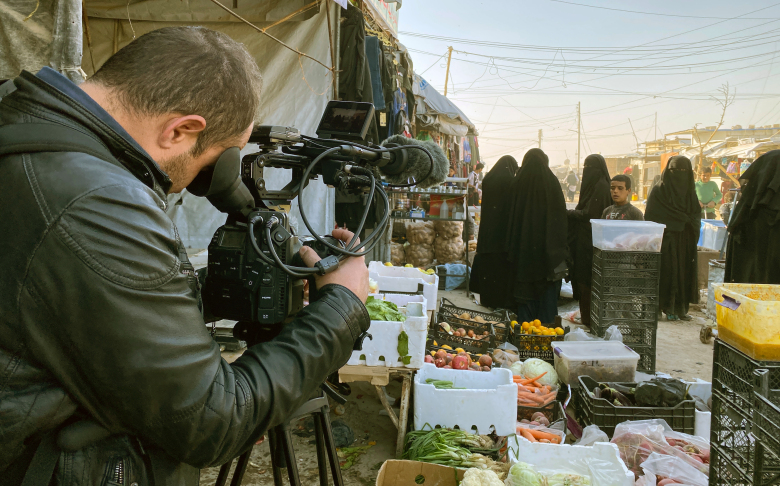
“Sabaya” director Hogir Hirori
Lolav Media
Section: World Cinema Documentary Competition
Dir/DoP: Hogir Hirori
Format: 1080p
Camera: Canon C300 II
Lens: Canon 24-70 f/2.8
Hirori: I have previously used different kinds of professional cameras, and I own a Canon DSLR and several Canon lenses myself. But, as I knew filming in Syria was going to be challenging, I decided to invest in a new camera that was up for the task. I wanted to be able to film on the go using available ambient or on camera lighting, both at night and in the daytime. I was going for a raw reality based in action feel, filming as things happened with no staged interviews or use of accessory stationary lighting. Therefore, I needed a portable, easily handheld, and light weight camera. But I also wanted one that could produce a high image quality, had two XLR sound input terminals and at least two memory card slots. It was important that I could get the camera in and out of the bag quickly to start filming when opportunity arose.
I was looking for something a bit more advanced than my DSLR camera and decided to check what Canon had to offer to keep costs low and to be able to use my existing lenses with the new camera. I eventually chose a Canon EOS C300 II and brought three of my Canon lenses with me (a standard zoom 24–70 mm f/2.8 for in action, a telephoto 70–200 mm f/2.8 for wider exterior shots and a 50 mm f/1.4). In Syria I would be constantly moving places and filming in potentially dangerous locations, so I made sure I could carry everything I had in one backpack. Since I knew that it would be hard to find a replacement camera or filming equipment in case something happened to my gear in Syria, I also brought my old DSLR and a Gopro just in case.
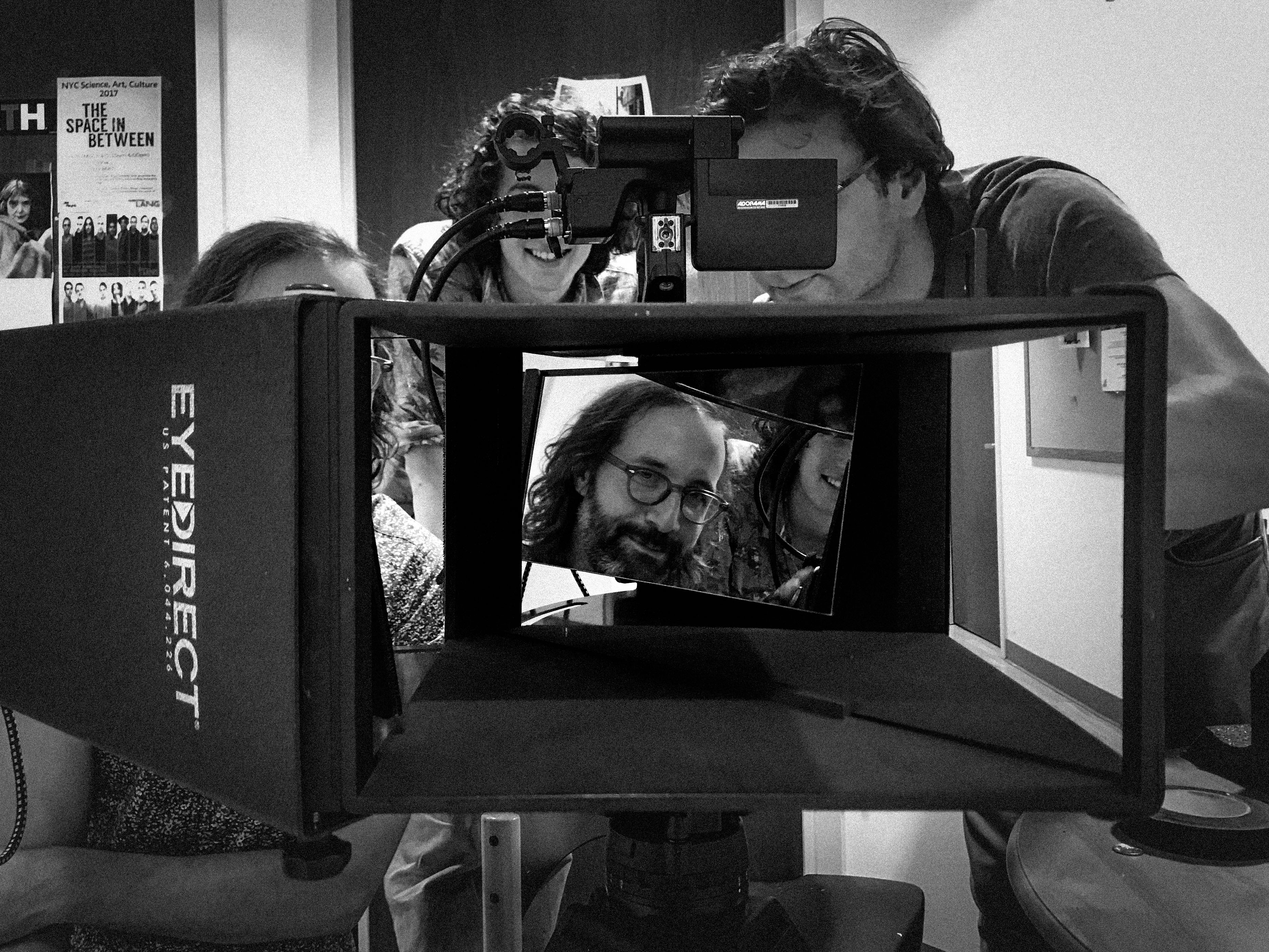
The “Searchers” filmmaking team
courtesy of filmmakers
Section: NEXT
Dir: Pacho Velez, DoP: Daniel Claridge & Martin DiCicco
Format: 4K (S35)
Camera: Canon C300mkII
Lens: Zeiss 28-80mm & 70-200mm Compact Zooms
Claridge/DiCicco: The C300mkII has been a good workhorse for our documentary work for years, it has nice detail and a latitude that is good in exteriors and sufficient in less than desirable lighting conditions. We coupled that with the Zeiss Compact Zooms which we found to be quite sharp and flattering when wide-open. For us, the lens was a kind of two way portal, as it also served as the backplate on which the subjects’ dating profiles were projected (using a teleprompter). There’s an intimacy and distortion inherent to that shared usage, complicated by the fact that subjects are then looking at profile pictures taken by cameras and designed to be viewed through screens. So the visual choices, from the balanced compositions to the wider focal lengths, were all intended to service this sense of refraction, both as a stylistic statement and as a bit of a metaphor for how online dating operates through a skein of lenses and screens.
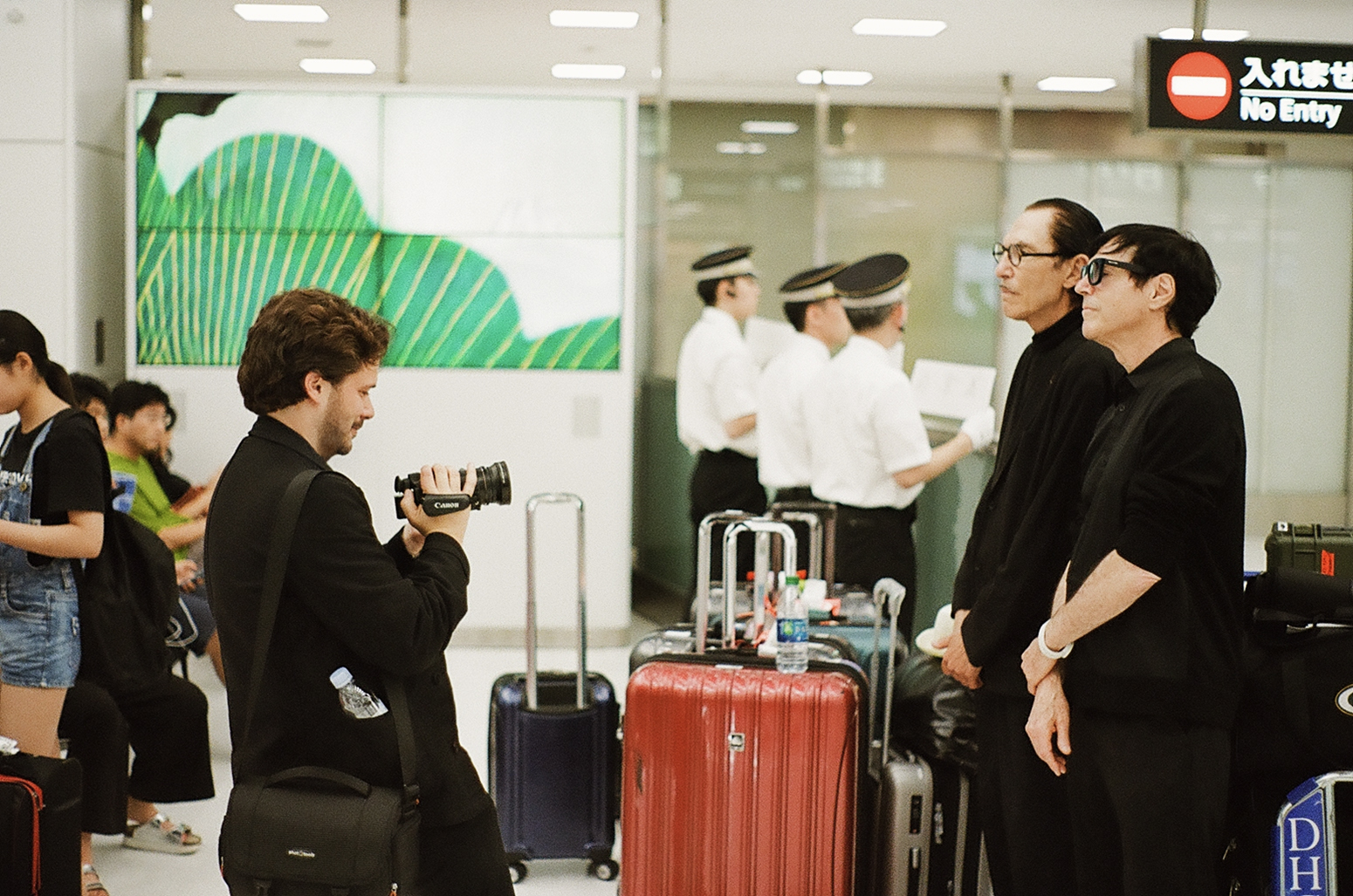
Director Edgar Wright shooting “The Spark Brothers”
courtesy of filmmaker
Section: Premieres
Dir: Edgar Wright, DoP: Jake Polonsky
Format: RED R3D 8K
Camera: RED Monstro Monochrome w’EyeDirect
Lens: Panavision Primo Artiste
Polonsky: These were the right tools for the job because Edgar had come to me with the idea that he wanted the interviews to have the look of Richard Avedon’s picture of the band that graces the cover of the Big Beat album from 1976, which was shot on large format black and white. I thought it would be fun to try and find a way of capturing something in large format monochrome, and went to David Webb at RED in London to discuss whether they might be able to let us take a look at a monochrome RED Monstro camera.
I shot some tests and was very impressed with the image quality and feel of the camera. I then needed some large format lenses to pair with the camera. Of the options we looked at through Panavision, the Primo Artistes had the best combination of cosmetic softness and detail to be our portraiture lenses. In order to get the most direct connection with our subjects, we also used an Eye Direct beam splitter system, so all our interviewees could look straight down the lens and see Edgar reflected there. We set about creating a repeatable two camera set up so that all the interviews ‘matched’ no matter where we filmed them – which ended up comprising a mixture of shoots in LA, New York and London. And through the generous support of RED and Panavision we were able to source mono cameras and Primo Artiste lenses for almost all the shoots.
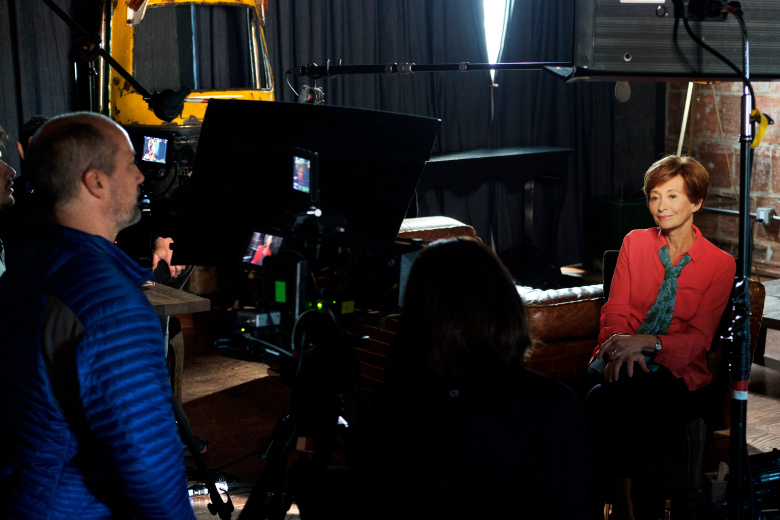
“Street Gang: How We Got to Sesame Street” cinematographer Luke Geissbühler
Jason Robinette
Section: Premieres
Dir: Marilyn Agrelo, DoP: Luke Geissbühler
Format: Red 6k RAW
Camera: Red Weapon
Lens: Canon CNE Speed Primes
Geissbühler: When I visualized the look of “Street Gang” before filming with producer Trevor Crafts and director Marilyn Agrelo, a large consideration was how the modern interviews would intercut with the wonderful archive material from the 60’s and 70’s. The archives were a fantastic mix of 16mm, 35mm, Kinescope, and early video and would be used for the bulk of the film. We decided that we didn’t want to blend the interviews with a similar look, this would have been potentially confusing. We opted to shoot the interviews in a modern, clean, and flattering aesthetic with rather wide frames in a high resolution to capture the whole interviewee but still be able to absorb the subtleties of the face.
This method resulted in a decidedly sharp contrast whenever we cut back to the archive material, triggering an appreciation for the old formats and transporting us back to this wonderful time soaked in nostalgia. Buffalo 8’s terrific color correction by Mark Todd Osborne finessed the wild array of looks, balancing this contrast of the old and new while preserving the integrity of the archive. People’s memory and tolerances of video quality is ever changing as our standards and tastes evolve. Trying to correct relatively poor quality material so that it feels like how you remember it was no small task.
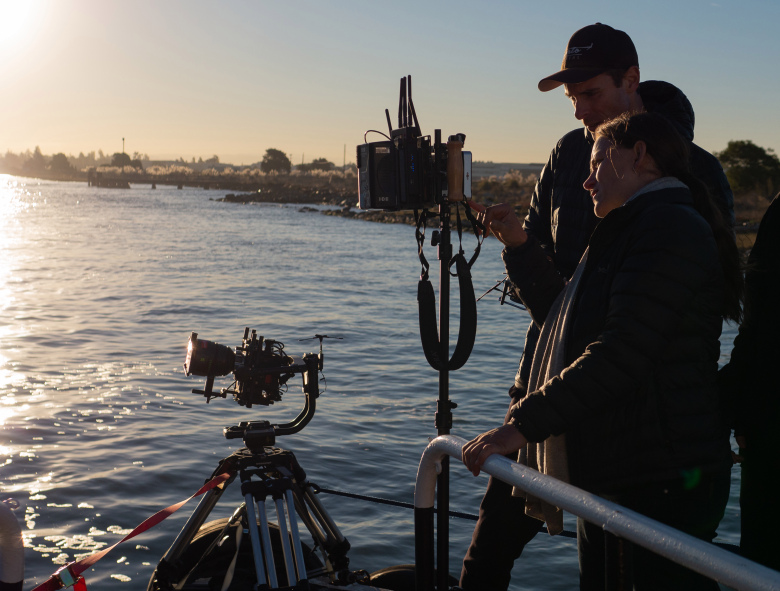
“Users” director Natalia Almada and DoP Bennett Cerf
courtesy of filmmaker
Section: U.S. Documentary Competition
Dir: Natalia Almada, DoP: Bennett Cerf
Format: 5K Raw R3D
Camera: RED Gemini and ocassional Blackmagic Pocket 6K
Lens: Master Primes (18mm, 35mm, 100mm Macro)
Cerf: “Users” is an essay film that’s meant to question the notion of whether technology-progress is the same as human-progress. The subject matter is expansive, which underscored the importance of creating epic imagery to communicate it. We wanted the film to feel grand and yet intimate. Natalia wanted to have formal aesthetic rules to follow. The camera wasn’t to pan, tilt or move. We ignored the rules sometimes, but they were always there to fall back on. It’s the same in my narrative and commercial work as well. I usually start with certain visual metaphors or style in mind and then shift according to the content or situation. Natalia had also said she wanted a large format feel like “Baraka” or “Samsara,” which were shot on 65mm film.
One of our sponsors offered us a choice of the RED Helium, Monstro, Gemini, and the Arri LF to use throughout our shoot. The Red Gemini was the best balance of low-noise, high-resolution, and lightweight form-factor. Also, the Gemini’s small body allowed me to rig the camera in more environments on my own than a larger camera. It worked in our underwater housing, two different gimbals and in two teleprompter rigs. Since the Gemini wasn’t a large format sensor, I decided that faster, high resolution lenses would give us that. Arri Master Primes were my first choice, and I was thrilled when the producers made space in the budget for them. They aren’t budget-friendly, but we reduced the cost a bit by bringing only 3 lenses on each shoot. They are very sharp, but the focus rolls off softly and their flares are almost pastel. The lens we used the most was the 35mm. It easily gave us the right perspective to get intimately close with our subjects without warping.
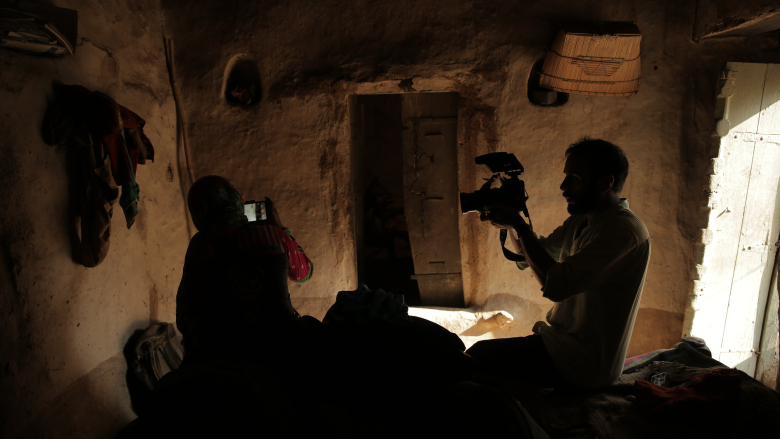
“Writing with Fire” director/co-cinematographer Sushmit Ghosh
courtesy of filmmaker
Section: World Cinema Documentary Competition
Dir: Sushmit Ghosh & Rintu Thomas DoP: Sushmit Ghosh & Karan Thapliyal
Format: HD
Camera: Canon 5D Mark III
Lens: Canon 24-70, 50 (1.4) and 28 (1.
Ghosh: Our film is set in the Indian state of Uttar Pradesh, which is a deeply fraught landscape — caste discrimination, violence against women and political corruption seep into each other and this matrix dictates everyday life. The biggest challenge was in filming with our characters, who were mostly working in extremely hostile spaces — reporting from illegal mines run by powerful mafia, in police stations where rolling a camera is almost impossible, in meetings with politicians who are reluctant to be questioned by women with a camera…and also in spaces of deep grief — homes of rape survivors and families of murder victims.
We knew we had to have a quiet presence, with equipment that was almost invisible so that we didn’t interrupt the work of our characters and also maintained the sanctity of these moments that were unfolding between them and the people they were interacting with. We decided to strip down the crew to three — my co-director, co-cinematographer and myself. We filmed our story over four years and knew early we had to go with a unit that would be stable in extreme conditions — so we let go of our original plan of filming with the FS7 and stripped down our kit to two Canon DSLRs, deciding to shoot entirely handheld. This really helped us adapt to the physical stress of working in a region where average temperatures hover at 42 degree (108F), filming in situations that were unpredictable and potentially risky.
What does it feel like to jostle for space on rickety buses and overcrowded rickshaws, or to walk hours under the baking sun to get to villages that didn’t exist on maps? We wanted to give our audiences a visceral experience of these parts of India, yet maintain an intimate lens as the personal stories of our characters unfolded. We also developed a discreet sign-language as we shifted fluidly between angles and characters and lenses, both in the chaos of the physical landscape and deep silences of the inner worlds of our protagonists. We innovated and multi-tasked to create a cinematic landscape that is very close to how we had imagined it from the outset.
Check out our survey of this year’s narrative features right here.
The following films from the U.S. Documentary Competition, World Documentary Competition, and Premieres appear in alphabetical order by title.
“Ailey”
Section: U.S. Documentary Competition
Dir: Jamila Wignot, DoP: Naiti Gámez
Format: 4k
Camera: Canon c300 mkII & Canon c300 mkIII
Lens: Canon CN-E Cine primes; CN-E30-105mm zoom & L-series lenses.
Gámez: We wanted nimble and affordable documentary cameras and lenses that would allow us to film dancers, rehearsals and subjects in any setting. For the dance rehearsals, we really focused on capturing the nuances of the movements and the flow of the dancers’ interactions. For the sit-down interviews, we knew we wanted the sets and subjects to really shine. We wanted their stories to feel elevated and dramatized, yet contextualized. So, we decided on a look that was our imagined, hyper-stylized version of what “backstage” behind an Ailey production would look like: with props, cloths, grip equipment, and pieces of set designs framing them.
“All Light, Everywhere”

Corey Hughes Shooting “All Light, Everywhere”
courtesy of filmmaker
Section: U.S. Documentary Competition
Dir: Theo Anthony, DoP: Corey Hughes
Format: 4k, 1080p, 720p
Camera: Sony FS7 & FS5, D-Eye Retinal Cam, FLIR ONE, DJI Mavic & Inspire 2, Olfi one.five, Axon Body 2
Lens: Canon 30-300mm, Fujinon Cabrio 20-120mm, Zeiss CP.2 (15mm & 35mm), Canon 24-70mm, Leica Summicron 50mm
Hughes: Due to the kaleidoscopic nature of the project, weaving multiple narratives and histories together, the cinematography of the film developed with each section we filmed. The main threads of the film were shot on the Sony FS7 and FS5. We switched between shooting single camera on a Movi and filming multi-cam on tripods with cine zooms. The cine zooms allowed for flexibility in shooting in live environments while also creating some really beautiful and surreal images. The slow mechanical zooms replicate the movement of a surveillance camera, searching and tracking objects in a frame. What I love about the Movi is it produces these extremely digital feeling images. You can feel the operator behind the camera. It is trying so hard to make smooth images but it doesn’t always work. I love those flaws.
Many of the environments we were filming in were unknown with limited access so we had to be able to adapt to changing scenarios. Theo and I developed parameters to work within so that we had a guide for how to react to each new situation. For example, when filming the workers inside the Axon factory we felt it was important to highlight the physicality of the human labor that is inherent in producing tech devices, so one of the parameters became that the camera should always focus on the interaction between hands and objects when filming the workers in the factory.
The film pulls images from many different sources: body camera, software screen capture, aerial surveillance systems, archival materials from the early 20th century, etc. When working with these types of operational images, images created to serve a specific function in a process (ex. surveillance, facial recognition), we wanted them to appear as raw as possible. Respecting the material for what it is rather than trying to morph it into a more traditional cinema image. Grainy 720p Go-Pro footage or software screen capture can be just as powerful as well lit 4k raw footage if used in the right way. We were equally interested in creating compelling images as well as revealing the flaws and biases inherent in the way each camera sees the world.
“At the Ready”
Section: U.S. Documentary Competition
Dir/DoP: Maisie Crow
Format: 4K
Camera: C300 mkII, 5D mkIV, Panasonic Eva 1
Lens: Canon Zoom Lens CN-E 18-80mm, Canon Zoom Lens 24-70mm f/2.8, Canon Zoom Lens EF 70-300mm f/4-5.6L IS
Crow: The film was shot with a small crew to allow for intimate, unobtrusive access to the students and families we were filming. It was important for us to use cameras that could be operated by a single person so as not to interfere or distract from what was happening in front of the camera. I operated the main camera for the majority of production and ergonomically the C300MKII worked well with my small stature. It was a comfortable camera for me to work with during long shoot days.
“Captains of Zaatari”

“Captains of Zaatari” cinematographer Mahmoud Bashir
courtesy of filmmaker
Section: World Cinema Documentary Competition
Dir: Aly Elaraby, DoP: Mahmoud Bashir
Format: 2k s log 3 & raw
Camera: Sony a7s iii & Red dragon
Lens: Master prime
Bashir: The mix between the dslr camera and pl cinema lenses was my answer for this project. With a small camera I can hold it day and flow with the moment easily and catch moments when I didn’t know what would happen next. In addition, the Sony a7s supplied the option to shoot at night with high iso and high quality lenses, the exact balance and mood I needed.
“Cusp”

Isabel Bethencourt shooting “Cusp”
Isabel Bethencourt/Parker Hill
Section: U.S. Documentary Competition
Dir/DoP: Isabel Bethencourt and Parker Hill
Format: 2K Canon Log
Camera: Canon C300 Mk II
Lens: Zeiss Standard Speeds
Bethencourt/Hill: Since we were a two-person team for all of production, the C300 was a no brainer for its small footprint, built-in doc versatility, and low light performance. We could fit the whole thing in a backpack, which kept us super nimble for running around with teenagers at all hours. We loved the standard speeds for their texture and imperfections, and they’re also really small — we could get close to our characters without them feeling like they had a huge lens in their face. The limitation of the primes turned out to be one of our biggest advantages, since it encouraged us to physically move around the rooms we were in, constantly finding new angles and frames. We wanted the film to feel as vibrant and energetic as the girls are, so we were constantly thinking about color — strategically exposing the c300 to preserve color in the highlights, and using colored filters to enhance the golden Texas sun whenever possible.
“Flee”

Behind the scenes of “Flee”
Section: World Cinema Documentary Competition
Dir: Jonas Poher Rasmussen Art Dir: Jess Nicholls
Camera: We didn’t shoot, we drew.
Lens: As this is animation we didn’t use real lenses, but we aimed for a style matching lenses in a 35-70mm range
Rasmussen: As we were drawing our scenes by hand, we didn’t have to confront the camera question too much. There is a certain amount that can be faked, or distorted, in the perspective of a shot. At the same time, “FLEE” is an animated documentary and we really wanted to keep an authentic feel to it. We wanted fairly flat but realistic perspective, where we could show a good amount of landscape whilst keeping a lot of strong parallel lines. Our main types of shots were wide, establishing shots, that benefitted from the vastness of the space; medium close ups for dialogue and character interaction, where negative space and creating distance between characters was important; finally, extreme close ups were used for moments of high tension and stress, to isolate important objects or people from an out of focus background.
“Homeroom”

“Homeroom” cinematographer Sean Harvey
courtesy of filmmaker
Section: U.S. Documentary Competition
Dir: Peter Nicks, DoP: Sean Havey
Format: 4K
Camera: Sony F5 and A7S
Lens: Canon 24-70mm f2.8 and 70-200mm f2.8; Sigma 50mm T1.5
Nicks: Our films are all about proximity to character, bringing the audience into the emotional world of the people we are following. These are stories that sometimes span years that need to be shot on gear that we own. For these reasons we are typically unable to use expensive rigs and lens sets. We shot “Homeroom” on a combination of the Sony F5 and A7S with canon dslr zooms (24-70mm f2.8 and 70-200 f2.
 with camera support provided by a Movi gimbal and an EasyRig. This lens set is a great lightweight cost effective option for shooting vérité documentary. It offers versatility with foal range and a shallow depth of field, but not so much depth of field that focus is too much of a challenge. When appropriate we would shift to primes (Sigma 50mm T1.5) if we had more control over the scene and wanted a look/feel with more intimacy and character.
with camera support provided by a Movi gimbal and an EasyRig. This lens set is a great lightweight cost effective option for shooting vérité documentary. It offers versatility with foal range and a shallow depth of field, but not so much depth of field that focus is too much of a challenge. When appropriate we would shift to primes (Sigma 50mm T1.5) if we had more control over the scene and wanted a look/feel with more intimacy and character.“Misha and the Wolves”

“Misha and the Wolves” cinematographer Will Pugh
courtesy of filmmaker
Section: World Cinema Documentary Competition
Dir: Sam Hobkinson, DoP: Will Pugh
Format: 2K, Prores 4444
Camera: ARRI Alexa Mini
Lens: Angenieux Optimo T2.6 15-40mm, Angenieux Optimo T2.8 45-120mm
Pugh: This was not an observational documentary but a carefully constructed, retrospective story with lighting and design elements – ultimately envisaged for a big screen. We wanted a high level of image quality but equally a light footprint, to work in real locations with minimal crew. To that end, I shot with Alexa Mini at 2K, in Prores 4444, using Angenieux Optimo compact zooms 15-40mm and 45-120mm. Occasionally we used a TLS Morpheus 80-200mm and Tokina 100mm macro.
Despite different countries, locations and timeframes, we wanted our interviews to have stylistic cohesion, so locations were all carefully scouted, framed and lit. Interviews were conducted centre-frame and into-the-lens (using EyeDirect) which works well for first person testimony. This is a film about a dark period of history and about layers of deception. The visual style of the film is still and composed. We eschewed handheld. Movement where it exists is creeping or occasionally gliding. We wanted the lighting to feel natural but to have mood and contrast, and for the imagery to play with textures, frames and surfaces.
It goes without saying that 2020 was a tricky year for production, and of course our budget was limited, so director Sam Hobkinson took advantage of a family trip to Germany to film some snowy mountain scenes featuring his daughter – amazingly pulling it all off on his own using a Lumix GX8 with a 20mm lens mounted on a small gimbal. Outside of the U.S material I shot for Sam in 2015, we were unable to fly to the States in 2020 for a week’s shoot, which I ended up prepping and handing over to Stephen McCarthy, a great DOP based in Boston. Stephen did a seamless job with Sam directing remotely (thankfully there had been a scout pre-Covid!). This film was a long passion project for Sam and it was great to play a part in bringing this incredible story to life.
“My Name Is Pauli Murray”

“My Name Is Pauli Murray” cinematographer Claudia Raschke
Casey Joseph
Section: Premieres
Dir: Julie Cohen, Betsy West, DoP: Claudia Raschke
Format: 4K
Camera: Canon C300 Mk2
Lens: Canon Cinema Primes, 17-120mm Canon Cine Zoom, 18-80mm Canon Compact cine zoom
Raschke: “For My Name Is Pauli Murray” the Canon C300ii and the Canon cinema primes were a fantastic combination to express beautiful, glowing skin tones with a high contrast background, including deep shadow details and exquisite highlights, for the interview set-ups in our feature documentary. My natural soft lighting approach was inspired by the Dutch painter Jan Vermeer. Light source motivations were set up to match the particular location either with natural existing or imagined window sources while treating the background by setting specular highlights.
Choosing a shallow DOF and cinema primes allowed me to transform my lighting design into the painterly look I desired. The Canon sensor allowed me to maintain my cinematic style throughout the film and especially during challenging documentary situation. Without the sensor’s latitude and easy to modify camera settings I wouldn’t have been able to instantaneously capture and react to unpredictable cinéma vérité moments.
“Philly D.A.”

Behind the scenes of “Philly D.A.”
Ted Passon
Section: Premieres
Dir: Ted Passon, Yoni Brook, DoP: Yoni Brook
Format: 2K 444
Camera: Canon C300MK2, RED Gemini
Lens: Canon 24-70, 150-600
Brook: I wanted to put our audience in the seats of the most powerful people in the justice system: the prosecutors. They operate behind-closed-doors and our cinematography was an opportunity to pierce that bubble. As an observational docu-series, we shot nearly a thousand hours of intense meetings. Our scenes unfolded in ugly conference rooms with no opportunity to change the lighting.
To create a feeling of intimacy, I rested the camera on my hip pouch during long meetings to be at the same eye level as the people gathered around the conference tables. It was essential for myself and co-creators Ted Passon and Nicole Salazar, who often operated sound, to be in creative sync while being completely silent. That meant often just using eye movement and tracking the boom mic. For our cityscape scenes that showcase Philadelphia, I wanted to stay away from drones, and instead used vintage telephoto zooms to achieve the deep-focus of classic observational documentaries, like “Streetwise” and “The War Room.”
“Playing with Sharks”

Behind the scenes of “Playing with Sharks”
Section: World Cinema Documentary Competition
Dir: Sally Aitken, DoP: Ron Taylor, Judd Overton, Nathan Barlow, Michael Latham, Jono Heighes
Format: 16mm, 35mm, 4k
Camera: Arri Alexa Mini, additional cameras: Sony F55 a7iii DJI Mavic 2 Drone (Plus archival cameras: 16mm and 35mm Bolex and Arri)
Lens: XEEN Cine Prime Lenses
Aitken: “Playing with Sharks” is Valerie Taylor’s incredible story — pioneering shark expert, fearless underwater icon, and maverick conservationist. With both archival and contemporary footage in the film I was keen to honor Ron Taylor’s incredible film library gathered over a half century as well as reflect the energetic vibrancy and sage wisdom of 85-year-old Valerie today. So this movie is a contemporary story and a journey through time… something of an artistic challenge!
Ron’s remarkable underwater scenes from the 1950s, 60s, and 70s were brought back to life after production company Wildbear Entertainment contracted the Blackmagic cintel scanner. The colors in the film stock popped brilliantly, and the quality of the image had not diminished. What Ron captured, reefs swimming with plentiful sharks, have however become almost impossible to film today — the confronting realities of a depleted ocean.
Our contemporary cinematography; shot by Judd Overton, Nathan Barlow and Michael Latham, of Valerie in the present day still diving without Ron. The impressionistic imagery I wanted to film, such as the ‘tinny’ (the Taylor’s runabout boat), and all our interviews required a clean modern look with high-end cameras and prime lenses for beauty. We wanted to intercut present-day with the past, and so an Alexa Mini afforded us some maneuverability while on location and also a high quality look for observational sequences.
A DJI mavick 2 drone swept along the Australian coastline, and also in Fiji, helping us realize grand scale in our climactic scene of Valerie free diving with Bull sharks with a small dive boat set against the epic blue of the Pacific Ocean. These kinds of aerial images were impossible to achieve in Ron’s time (without enormous budget) so they further enhanced the experience of the present against the past. I also wanted to fully immerse viewers in the magnificent underwater experience of the Fiji dive. Again, the Alexa Mini was used, with principal underwater filming from Valerie’s nephew, Jono Heighes, who apprenticed under Ron Taylor. The 60-odd Bull sharks swirling around an octogenarian in a pink wetsuit also play their part in making the scene magnificent!
“Rebel Hearts”

Shooting “Rebel Hearts”
courtesy of filmmaker
Section: U.S. Documentary Competition
Dir/DoP: Pedro Kos
Format: 4k, HD, DV
Camera: Canon C300 mark 2
Lens: Canon L Series, 35mm prime and 70-200
Kos: “Rebel Hearts” is told with a combination of archival footage of various formats, animation and motion graphics, and original contemporary footage. We wanted the contemporary footage to help ground and frame the story in the present. We love the look of the Canon C300 Mark 2, and the Canon lenses. They allowed us to be nimble, intimate and at the same time have a rich and cinematic look that feels like the here and now, and yet blends well with all the other elements.
“Sabaya”

“Sabaya” director Hogir Hirori
Lolav Media
Section: World Cinema Documentary Competition
Dir/DoP: Hogir Hirori
Format: 1080p
Camera: Canon C300 II
Lens: Canon 24-70 f/2.8
Hirori: I have previously used different kinds of professional cameras, and I own a Canon DSLR and several Canon lenses myself. But, as I knew filming in Syria was going to be challenging, I decided to invest in a new camera that was up for the task. I wanted to be able to film on the go using available ambient or on camera lighting, both at night and in the daytime. I was going for a raw reality based in action feel, filming as things happened with no staged interviews or use of accessory stationary lighting. Therefore, I needed a portable, easily handheld, and light weight camera. But I also wanted one that could produce a high image quality, had two XLR sound input terminals and at least two memory card slots. It was important that I could get the camera in and out of the bag quickly to start filming when opportunity arose.
I was looking for something a bit more advanced than my DSLR camera and decided to check what Canon had to offer to keep costs low and to be able to use my existing lenses with the new camera. I eventually chose a Canon EOS C300 II and brought three of my Canon lenses with me (a standard zoom 24–70 mm f/2.8 for in action, a telephoto 70–200 mm f/2.8 for wider exterior shots and a 50 mm f/1.4). In Syria I would be constantly moving places and filming in potentially dangerous locations, so I made sure I could carry everything I had in one backpack. Since I knew that it would be hard to find a replacement camera or filming equipment in case something happened to my gear in Syria, I also brought my old DSLR and a Gopro just in case.
“Searchers”

The “Searchers” filmmaking team
courtesy of filmmakers
Section: NEXT
Dir: Pacho Velez, DoP: Daniel Claridge & Martin DiCicco
Format: 4K (S35)
Camera: Canon C300mkII
Lens: Zeiss 28-80mm & 70-200mm Compact Zooms
Claridge/DiCicco: The C300mkII has been a good workhorse for our documentary work for years, it has nice detail and a latitude that is good in exteriors and sufficient in less than desirable lighting conditions. We coupled that with the Zeiss Compact Zooms which we found to be quite sharp and flattering when wide-open. For us, the lens was a kind of two way portal, as it also served as the backplate on which the subjects’ dating profiles were projected (using a teleprompter). There’s an intimacy and distortion inherent to that shared usage, complicated by the fact that subjects are then looking at profile pictures taken by cameras and designed to be viewed through screens. So the visual choices, from the balanced compositions to the wider focal lengths, were all intended to service this sense of refraction, both as a stylistic statement and as a bit of a metaphor for how online dating operates through a skein of lenses and screens.
“The Sparks Brothers”

Director Edgar Wright shooting “The Spark Brothers”
courtesy of filmmaker
Section: Premieres
Dir: Edgar Wright, DoP: Jake Polonsky
Format: RED R3D 8K
Camera: RED Monstro Monochrome w’EyeDirect
Lens: Panavision Primo Artiste
Polonsky: These were the right tools for the job because Edgar had come to me with the idea that he wanted the interviews to have the look of Richard Avedon’s picture of the band that graces the cover of the Big Beat album from 1976, which was shot on large format black and white. I thought it would be fun to try and find a way of capturing something in large format monochrome, and went to David Webb at RED in London to discuss whether they might be able to let us take a look at a monochrome RED Monstro camera.
I shot some tests and was very impressed with the image quality and feel of the camera. I then needed some large format lenses to pair with the camera. Of the options we looked at through Panavision, the Primo Artistes had the best combination of cosmetic softness and detail to be our portraiture lenses. In order to get the most direct connection with our subjects, we also used an Eye Direct beam splitter system, so all our interviewees could look straight down the lens and see Edgar reflected there. We set about creating a repeatable two camera set up so that all the interviews ‘matched’ no matter where we filmed them – which ended up comprising a mixture of shoots in LA, New York and London. And through the generous support of RED and Panavision we were able to source mono cameras and Primo Artiste lenses for almost all the shoots.
“Street Gang: How We Got to Sesame Street”

“Street Gang: How We Got to Sesame Street” cinematographer Luke Geissbühler
Jason Robinette
Section: Premieres
Dir: Marilyn Agrelo, DoP: Luke Geissbühler
Format: Red 6k RAW
Camera: Red Weapon
Lens: Canon CNE Speed Primes
Geissbühler: When I visualized the look of “Street Gang” before filming with producer Trevor Crafts and director Marilyn Agrelo, a large consideration was how the modern interviews would intercut with the wonderful archive material from the 60’s and 70’s. The archives were a fantastic mix of 16mm, 35mm, Kinescope, and early video and would be used for the bulk of the film. We decided that we didn’t want to blend the interviews with a similar look, this would have been potentially confusing. We opted to shoot the interviews in a modern, clean, and flattering aesthetic with rather wide frames in a high resolution to capture the whole interviewee but still be able to absorb the subtleties of the face.
This method resulted in a decidedly sharp contrast whenever we cut back to the archive material, triggering an appreciation for the old formats and transporting us back to this wonderful time soaked in nostalgia. Buffalo 8’s terrific color correction by Mark Todd Osborne finessed the wild array of looks, balancing this contrast of the old and new while preserving the integrity of the archive. People’s memory and tolerances of video quality is ever changing as our standards and tastes evolve. Trying to correct relatively poor quality material so that it feels like how you remember it was no small task.
“Users”

“Users” director Natalia Almada and DoP Bennett Cerf
courtesy of filmmaker
Section: U.S. Documentary Competition
Dir: Natalia Almada, DoP: Bennett Cerf
Format: 5K Raw R3D
Camera: RED Gemini and ocassional Blackmagic Pocket 6K
Lens: Master Primes (18mm, 35mm, 100mm Macro)
Cerf: “Users” is an essay film that’s meant to question the notion of whether technology-progress is the same as human-progress. The subject matter is expansive, which underscored the importance of creating epic imagery to communicate it. We wanted the film to feel grand and yet intimate. Natalia wanted to have formal aesthetic rules to follow. The camera wasn’t to pan, tilt or move. We ignored the rules sometimes, but they were always there to fall back on. It’s the same in my narrative and commercial work as well. I usually start with certain visual metaphors or style in mind and then shift according to the content or situation. Natalia had also said she wanted a large format feel like “Baraka” or “Samsara,” which were shot on 65mm film.
One of our sponsors offered us a choice of the RED Helium, Monstro, Gemini, and the Arri LF to use throughout our shoot. The Red Gemini was the best balance of low-noise, high-resolution, and lightweight form-factor. Also, the Gemini’s small body allowed me to rig the camera in more environments on my own than a larger camera. It worked in our underwater housing, two different gimbals and in two teleprompter rigs. Since the Gemini wasn’t a large format sensor, I decided that faster, high resolution lenses would give us that. Arri Master Primes were my first choice, and I was thrilled when the producers made space in the budget for them. They aren’t budget-friendly, but we reduced the cost a bit by bringing only 3 lenses on each shoot. They are very sharp, but the focus rolls off softly and their flares are almost pastel. The lens we used the most was the 35mm. It easily gave us the right perspective to get intimately close with our subjects without warping.
“Writing with Fire”

“Writing with Fire” director/co-cinematographer Sushmit Ghosh
courtesy of filmmaker
Section: World Cinema Documentary Competition
Dir: Sushmit Ghosh & Rintu Thomas DoP: Sushmit Ghosh & Karan Thapliyal
Format: HD
Camera: Canon 5D Mark III
Lens: Canon 24-70, 50 (1.4) and 28 (1.

Ghosh: Our film is set in the Indian state of Uttar Pradesh, which is a deeply fraught landscape — caste discrimination, violence against women and political corruption seep into each other and this matrix dictates everyday life. The biggest challenge was in filming with our characters, who were mostly working in extremely hostile spaces — reporting from illegal mines run by powerful mafia, in police stations where rolling a camera is almost impossible, in meetings with politicians who are reluctant to be questioned by women with a camera…and also in spaces of deep grief — homes of rape survivors and families of murder victims.
We knew we had to have a quiet presence, with equipment that was almost invisible so that we didn’t interrupt the work of our characters and also maintained the sanctity of these moments that were unfolding between them and the people they were interacting with. We decided to strip down the crew to three — my co-director, co-cinematographer and myself. We filmed our story over four years and knew early we had to go with a unit that would be stable in extreme conditions — so we let go of our original plan of filming with the FS7 and stripped down our kit to two Canon DSLRs, deciding to shoot entirely handheld. This really helped us adapt to the physical stress of working in a region where average temperatures hover at 42 degree (108F), filming in situations that were unpredictable and potentially risky.
What does it feel like to jostle for space on rickety buses and overcrowded rickshaws, or to walk hours under the baking sun to get to villages that didn’t exist on maps? We wanted to give our audiences a visceral experience of these parts of India, yet maintain an intimate lens as the personal stories of our characters unfolded. We also developed a discreet sign-language as we shifted fluidly between angles and characters and lenses, both in the chaos of the physical landscape and deep silences of the inner worlds of our protagonists. We innovated and multi-tasked to create a cinematic landscape that is very close to how we had imagined it from the outset.


